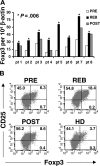IL-2 administration increases CD4+ CD25(hi) Foxp3+ regulatory T cells in cancer patients
- PMID: 16304057
- PMCID: PMC1473973
- DOI: 10.1182/blood-2005-06-2399
IL-2 administration increases CD4+ CD25(hi) Foxp3+ regulatory T cells in cancer patients
Abstract
Interleukin-2 (IL-2) is historically known as a T-cell growth factor. Accumulating evidence from knockout mice suggests that IL-2 is crucial for the homeostasis and function of CD4+ CD25+ regulatory T cells in vivo. However, the impact of administered IL-2 in an immune intact host has not been studied in rodents or humans. Here, we studied the impact of IL-2 administration on the frequency and function of human CD4+ CD25(hi) T cells in immune intact patients with melanoma or renal cancer. We found that the frequency of CD4+ CD25(hi) T cells was significantly increased after IL-2 treatment, and these cells expressed phenotypic markers associated with regulatory T cells. In addition, both transcript and protein levels of Foxp3, a transcription factor exclusively expressed on regulatory T cells, were consistently increased in CD4 T cells following IL-2 treatment. Functional analysis of the increased number of CD4+ CD25(hi) T cells revealed that this population exhibited potent suppressive activity in vitro. Collectively, our results demonstrate that administration of high-dose IL-2 increased the frequency of circulating CD4+ CD25(hi) Foxp3+ regulatory T cells. Our findings suggest that selective inhibition of IL-2-mediated enhancement of regulatory T cells may improve the therapeutic effectiveness of IL-2 administration.
Figures





Similar articles
-
Characterization of CD4+CD25+ regulatory T cells in patients treated with high-dose interleukin-2 for metastatic melanoma or renal cell carcinoma.J Clin Oncol. 2006 Mar 1;24(7):1169-77. doi: 10.1200/JCO.2005.03.6830. J Clin Oncol. 2006. PMID: 16505437
-
Effects of the administration of high-dose interleukin-2 on immunoregulatory cell subsets in patients with advanced melanoma and renal cell cancer.Clin Cancer Res. 2007 Apr 1;13(7):2100-8. doi: 10.1158/1078-0432.CCR-06-1662. Clin Cancer Res. 2007. PMID: 17404092 Clinical Trial.
-
Defining a functionally distinct subset of human memory CD4+ T cells that are CD25POS and FOXP3NEG.Eur J Immunol. 2012 Jul;42(7):1893-905. doi: 10.1002/eji.201242444. Eur J Immunol. 2012. PMID: 22585674
-
Lymphopenia and interleukin-2 therapy alter homeostasis of CD4+CD25+ regulatory T cells.Nat Med. 2005 Nov;11(11):1238-43. doi: 10.1038/nm1312. Epub 2005 Oct 16. Nat Med. 2005. PMID: 16227988
-
The dual role of the X-linked FoxP3 gene in human cancers.Mol Oncol. 2011 Apr;5(2):156-63. doi: 10.1016/j.molonc.2011.03.001. Epub 2011 Mar 30. Mol Oncol. 2011. PMID: 21489891 Free PMC article. Review.
Cited by
-
Immune targeting of three independent suppressive pathways (TIGIT, PD-L1, TGFβ) provides significant antitumor efficacy in immune checkpoint resistant models.Oncoimmunology. 2022 Oct 1;11(1):2124666. doi: 10.1080/2162402X.2022.2124666. eCollection 2022. Oncoimmunology. 2022. PMID: 36211806 Free PMC article.
-
Complete clinical responses to cancer therapy caused by multiple divergent approaches: a repeating theme lost in translation.Cancer Manag Res. 2012;4:137-49. doi: 10.2147/CMAR.S31887. Epub 2012 May 28. Cancer Manag Res. 2012. PMID: 22740774 Free PMC article.
-
Heterodimeric IL-15 in Cancer Immunotherapy.Cancers (Basel). 2021 Feb 17;13(4):837. doi: 10.3390/cancers13040837. Cancers (Basel). 2021. PMID: 33671252 Free PMC article. Review.
-
Arming Immune Cells for Battle: A Brief Journey through the Advancements of T and NK Cell Immunotherapy.Cancers (Basel). 2021 Mar 23;13(6):1481. doi: 10.3390/cancers13061481. Cancers (Basel). 2021. PMID: 33807011 Free PMC article. Review.
-
Human NK cells and cancer.Oncoimmunology. 2024 Jul 16;13(1):2378520. doi: 10.1080/2162402X.2024.2378520. eCollection 2024. Oncoimmunology. 2024. PMID: 39022338 Free PMC article. Review.
References
-
- Morgan DA, Ruscetti FW, Gallo R. Selective in vitro growth of T lymphocytes from normal human bone marrows. Science. 1976;193: 1007-1008. - PubMed
-
- Rosenberg SA, Yang JC, Topalian SL, et al. Treatment of 283 consecutive patients with metastatic melanoma or renal cell cancer using high-dose bolus interleukin 2. J Am Med Assoc. 1994;271: 907-913. - PubMed
-
- Malek TR, Bayer AL. Tolerance, not immunity, crucially depends on IL-2. Nat Rev Immunol. 2004;4: 665-674. - PubMed
Publication types
MeSH terms
Substances
Grants and funding
LinkOut - more resources
Full Text Sources
Other Literature Sources
Medical
Research Materials
Miscellaneous

